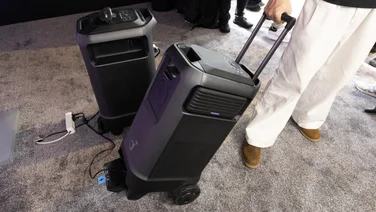To help us provide you with free impartial advice, we may earn a commission if you buy through links on our site. Learn more









- Fabulous camera with 1in sensor
- Upwards facing object avoidance
- 5K video recording at 30fps and 150Mbits/sec
- No C classification yet
I wasn’t able to fly the DJI Air 2S’ predecessor due to lockdown restrictions in 2020, but that’s no big deal. Arriving just one year after the DJI Mavic Air 2, the DJI Air 2S is a better drone all round and brings major improvements in several key areas.
A fantastic camera, consistent and responsive flight controls and impressive object avoidance and tracking make this DJI’s best consumer drone to date.
DJI Air 2S review: What do you get for the money?
The DJI Air 2S might be a significant upgrade, but it’s also significantly more expensive than its predecessor. It costs £899 – £120 more than the Mavic Air 2 was when it first launched – and this is only for the basic package with one battery, the remote control unit, plus one spare pair of propellers.
READ NEXT: The best action cameras to buy today
If you want to fly for longer than 31 minutes at a time, you’re better off going for the Fly More Combo package, which costs even more at £1,169. This adds two more batteries and an extra pair of spare propellers, plus a host of extras, including a soft carry case, a handy USB battery charging station and a set of ND filters.

From the outside, it doesn’t look vastly different to the Mavic Air 2. It’s a tiny bit taller, measuring 97 x 180 x 77mm (WDH) when folded, and weighs 25g more at 595g, but from a practical standpoint, hardly anything has changed. The remote control is the same one used by the DJI Mavic Air 2 and the DJI Mavic Mini, and the Air 2S is operated using the same DJI Fly app. Anyone who has used either of DJI’s recent drones will be right at home.
Look closer and you’ll see some pretty major changes have been made, however. The first of these is visibly obvious: DJI has added a pair of sensors on the top at the front, lending the drone a rather bug-eyed look, but also upgrading the object avoidance system from three-way to four-way. In layman’s terms, this means the DJI Air 2S can now detect objects above as well as to the front, rear and below.
A slightly more difficult upgrade to detect is that the camera has been given a huge overhaul. The previous Air focused on higher-resolution images and video modes, with the ability to capture 48MP images and 4K video at up to 60fps. The DJI Air 2S drops the megapixels to a maximum 20MP, instead doubling the size of the sensor. It boosts video resolution to 5.4K (5,472 x 3,078) at up to 30fps with a maximum bit rate of 150Mbits/sec (compared with 120Mbits/sec). And it adds the ability to record 10-bit D-Log M footage, for easier colour grading when editing.

Other new features are less significant. Master Shots lets you press one button and have the drone perform a series of automated manoeuvres, which the DJI Fly app then edits into a clip for you. SmartPhoto mode adds a sprinkling of AI to the drone’s stills photography capabilities, adjusting tone and exposure and switching between HDR and multi-frame low-light mode depending on the lighting conditions.
Finally, DJI brings improved image stabilisation to the Air 2S in the form of RockSteady EIS, ensuring super-smooth video and sharp photos, even in windy conditions.
DJI Air 2S review: What’s it like to set up and fly?
Setting it up is a doddle: just download the DJI Fly app on your phone (both Android and iOS are supported), connect the phone to the remote control with the supplied cable and mount it in the clip at the top.
Once you’ve switched on the drone and the remote control and connected your phone to the remote, pairing is swift and reliable. As with all DJI drones, the first time you take to the air you get the chance to engage beginner mode, which takes you through the various features of the app, and limits speed, altitude and range while you find your feet.

Once you’re comfortable flying the drone, you have a choice of three modes: Cinematic, which keep moves slow and smooth, and limits speed to 11mph so video recordings look professional; Normal, which is more responsive and speedy, flying at a maximum of 33mph; and Sport mode, which ups the velocity to 42.5mph but disables the object avoidance system, so requires considerable care.
In all modes, the Air 2S flies predictably, responding to inputs from the remote control’s sticks instantaneously, inspiring complete confidence. It’s a great drone for beginners and experienced pilots alike.
It’s surprisingly quiet, too – DJI says it has reprofiled the propellers to be less intrusive and, on a windless day, the 40Wh battery will deliver up to 31 minutes of flight time per charge. Something else that inspires confidence is the range at which video can be streamed from the drone to your phone’s display. With the help of the new OcuSync 3 transmission system, it will deliver images from an impressive 12km away.

Not that you’d ever want to be flying it this far away: it’s illegal to fly a drone in the UK you can’t see with your own eyes.
As for the object avoidance system, that’s as impressive as it’s ever been, and the addition of an additional pair of upwards-facing cameras means that the DJI Air 2S is even harder to crash than before. It still lacks side-facing sensors, so you need to take extra care when strafing left and right or performing any kind of spiral or circular manoeuvre, but it’s great for added peace of mind.
The system is very effective, too. I flew the drone directly at a variety of objects – a tree, a bramble bush, myself – and it detected the objects every time, stopping in good time and giving a warning both on the screen and with a haptic buzz. You can set it to either stop when obstacles are detected or, if you’re using it to track you while you’re running or biking, to fly around detected objects automatically.
DJI Air 2S review: How good is the camera?
The new camera is the big attraction of the Air 2S. It’s capable of shooting video at up to 5K at 30fps, with bit rates of up to 150Mbits/sec, and it can capture stills in RAW and JPEG at up to 20MP via a lens with an 88-degree field of view and an aperture of f/2.8.

The main attraction, however, is size of the sensor: a large 1in CMOS unit, previously only available in the bigger, more expensive DJI Mavic 2 Pro (£1,349), which delivers stunning image quality that’s a big step up from previous Air drones and the DJI Mini 2.
Professional videographers will also appreciate the ability to capture in flat 10-bit D-Log M to provide the maximum dynamic range for colour grading in post, which is a new feature to the Air lineup. Plus, as usual, there’s a host of modes for both video and stills, including the aforementioned Master Shots mode, HDR panorama (vertical, wide-angle and “sphere”), timed and hyper-lapse shots, burst shooting and auto-bracketing.
Overall, I found that quality was simply superb. Both video and stills were bursting with detail, the larger sensor meaning there was much less likelihood of highlights blowing out in scenes with bright skies and darker areas in the landscape below.Just for the hell of it I took a photo with an iPhone 12 Pro Max and compared the quality with the same photo captured with the Air 2S in smart photo mode – there isn’t a huge amount in it.

The colour of the sky in the iPhone’s shot is rendered with more realism, but detail levels are generally equivalent and the colour problems are nothing you couldn’t fix with a little tinkering in Photoshop.
DJI Air 2S review: What don’t we like about it?
Before you splash out on a DJI Air 2S, though, you need to be aware of one key thing, and that relates to recent changes to the law, which brought in a new system of drone and flight classifications. These new classifications, determined by the weight of the drone and its safety features, dictate the types of flights (also classified) that you can make.
Each type of drone (C0 to C4) falls into one or more flight classification: A1, where you’re allowed to fly over people; A2, where you’re allowed to fly near people; or A3, where you’re allowed to fly far from people.
The trouble is, these classifications have yet to be officially finalised, which means no drone, including the DJI Air 2S, has one yet; currently, that means it’s a “transitional” drone in the eyes of the law. That’s until 1 January 2023, when the rules come fully into effect. This means it’s legal to fly it but you’ll always have to fly it a minimum of 50m away from “uninvolved” people, and from 2023 it will become a “legacy drone” and you won’t be able to fly closer than 150m to built-up areas either.
That’s despite its low weight and advanced safety capabilities, which in future would almost certainly place it in the C2 category, allowing you (with the correct “A2CofC” qualification) to fly much closer to people and buildings. There’s currently no confirmation that existing drones will be able to be retroactively classified, but information on the DJI website does appear to indicate that may be a possibility: “Once the standards have been confirmed by the regulatory authorities and notified bodies are in place, we will publish a list on our website that shows which products will be included in drone class identification labelling, if possible.”
Having said all that, until very recently you’d have legally been obliged to fly 50m away from people anyway; all you’ll be missing out on is the potential ability to fly with more flexibility.
DJI Air 2S review: Should you buy it?
The key question is whether you should give DJI’s best consumer drone the cold shoulder and wait for the next model, which may well be classified. You could, but a year is a long time to wait.
Do you instead choose the DJI Mavic Mini 2, which can be flown legally both near to and over people? You could, but you’d miss out on the superior camera, feature set and longer battery life of the Air 2S.
In short, buying any drone that’s heavier than 250g is a bit of a risk right now, whether that be the Air 2Ss or any of its rivals. With that in mind, anyone just starting out on their drone-pilot journey would be better served by the DJI Mini 2, which falls just under that 250g limit and can be flown in more places, and closer to people, with minimal training.
What’s in no doubt at all, though, is that the DJI Air 2S is DJI’s best consumer drone yet for dedicated enthusiasts looking for a great-value option. It’s very portable, responsive and reliable in flight, and the superb image quality rounds off the package beautifully.








